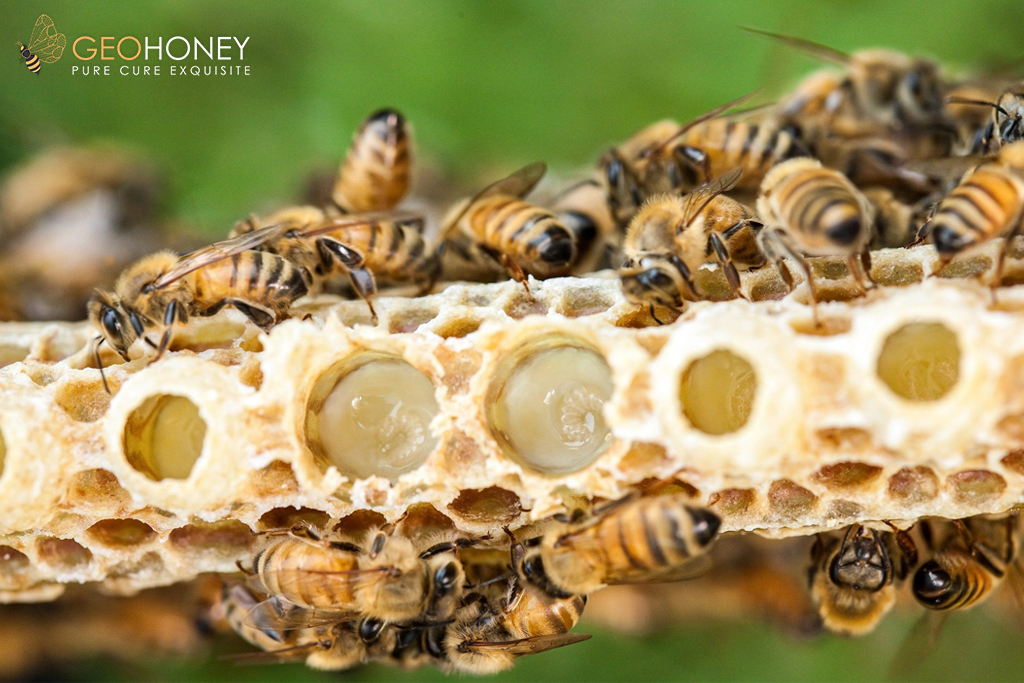- Tokyo: 17:53
- Singapore: 16:53
- Dubai: 12:53
- London: 08:53
- New York: 03:53
The Process of Making Royal Jelly

Honeybees are beautiful and fascinating creatures that produce almost six kinds of products, which includes Pollen, Royal Jelly, Propolis, Venom, Honey, and beeswax. Where, each product has its own uses.
Royal Jelly is a secretion of honey bees other than Natural honey, that is used as nutrition for adult queens and larvae. Glands present in nurse bees’ hypopharynx secretes this jelly, which is fed to the whole colony of larvae, be it of any sex.
There is one fascinating thing about the use of royal jelly. When new queens are in the process of formation, the worker bees make special queen cells. The larvae present in these cells are provided with large amounts of jelly. Such feeding facilitates queen morphology along with the fully developed ovaries required to lay eggs. It is also used as an alternative medicine and sold as a dietary supplement to humans.
How is Royal Jelly Made?
The making of this jelly is a technical activity, it requires a piece of real knowledge, practice, and rigour by the beekeepers. In its natural state, royal jelly is mostly found in queen cells but in small quantities. Therefore, beekeepers have to induce more breeding of queens, for more production of this jelly. The steps of this process are as follows.
1. Grafting
The beekeeper looks inside hives for rearing the larvae and observing the frames where the queen usually lays eggs. After a cell hatches, every larva is the same, but which among them will be queen is based on the royal jelly quantity being fed to some of them. After this, the beekeepers perform a very important step, which is grafting. In that step, hatched young larvae are taken and placed in artificial cells present on wooden bars.
2. Slats insertion into the hive
The new frames which carry the transplanted cells are taken and deposited in the colonies that produce royal jelly. Further, the hives are divided into 2 parts. One part is orphan, where solely worker bees will have access. Another part is where the queen lays on the free frames. The new frame with transplanted cells is installed on the orphan side, to motivate bees to produce royal jelly. Moreover, the young larvae are then raised by filling those cells with royal jelly.
You might be inquisitive about why the frames are not installed on the Queen’s side of the hive. Well, on doing so, the Queen might have eliminated those larvae. As we all know, only one queen can rule a single colony.
3. The process of cutting the lids
Mostly, after a span of three days, the Royal Jelly reaches a maximum amount in the cells. The beekeeper will now proceed to harvest the jelly. On recovering the slats, the uncapping process will be initiated, and then the upper part of the cells which is made of wax is cut by them.
4. Releasing Step
You can remove the larvae present in artificial cells by suction. Further, the extracted royal jelly can be stored in the refrigerator directly. It is good to consume till 18 months, from the time of harvest.
This process of royal jelly making is natural, it doesn’t involve the artificial feeding of bees. No protein substitutes like soybean or brewer’s yeast and sugar syrups are used for feeding them during the production period. It is a production procedure, which is respectful to the bee’s health and environment.




What a very useful information, I must try it and would love it.
As I read about this royal jelly, it crossed my mind that this is what I really need right now, in terms of the benefits that it has.
Now i know, why royal jelly is expensive. Very fascinating knowing all the benefits and this very helpful information.
Quite delicious and rich in nutrition, the royal jelly is best organic and natural dietary supplement. Daily consumption of royal jelly boosts immunity and offers a positive jibe.
So this is it, that's why the taste of this royal jelly is very unique and the smell is really like freshly harvested from bee secretion. And that's the reason why it is expensive, plus the benefits that you can get from it.